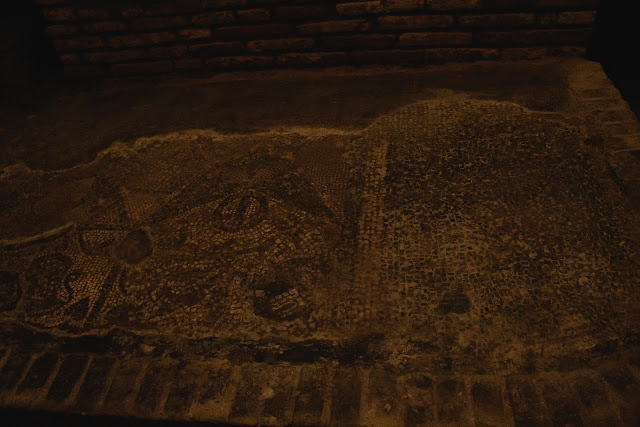I went to five churches before lunchtime (one about to have a wedding, one about to have a Mass, one actually in the middle of a wedding, one where I actually attended Mass, and one where a wedding had just ended). The first was Santi Cosma e Damiano.
The church is actually a part of the Roman Forum, and is built on top of an old temple to Romulus. It was converted to a church in the 6th century by Theoderic (the Gothic king whose tomb I saw in Ravenna). The main reason I was there was for the mosaics in the apse, from the 6th-7th century:
Sorry it's a bit dark; these churches are not especially well-lit, and I'm not using flash. I was surprised at the level of detail here, as it seems much higher than the other mosaics from that time period that I've seen. I'll have to do a little more research to see whether this is because of restorations over the centuries or something else.
Next up was the Basilica di San Marco. Quite different from its more famous cousin in Venice, the interior here is much more baroque in style:
Once again, I wasn't really there for the majority of the church, but rather the mosaics found in the apse:
Notice the design here: Christ, flanked by three people on either side, with the leftmost person (from the viewer's perspective) being the patron who built the church. Beneath, a procession of lambs going from Bethlehem and Jerusalem, with a lamb with a halo (Christ) in the middle. I ran into this same design in many of the churches I saw, and they all date to around the 9th century. I need to do a little a digging here, to see if this is a particularly Roman design, a design common in the 9th century, both, or neither. I saw something similar while in Ravenna (the procession of lambs), but this was in a much earlier church, Sant'Apollinare in Classe.
I next went to Santa Maria in Aracoeli, a church dating back to at least the 6th century but greatly renovated over the years. While it was beautiful, there was little of particular interest to me here. There were some medieval tombstones on the floor though, marking the burial places of important patrons of the church. It also houses the relics of St. Helena, the mother of Constantine. This is the church that was in the middle of a wedding, so I neglected to take any pictures (the last thing I need is an angry Italian bride yelling at me).
After this I attended Mass at San Nicolo in Carcere. Like Santa Maria, although the church was ancient it has been renovated so extensively that there wasn't many ancient things left. It is possible to view the ruins beneath the church, but apparently not immediately before or after Mass. Also, since I was there for a church service, I didn't take any pictures.
Next I went to Santa Sabina, at the top of the Aventine Hill (readers who watched the HBO series "Rome" may remember that this is where Titus Pullo and Lucius Vorenus live). The church dates back to the 5th century, its architectural integrity largely intact:
 |
| Original (I think) stonework |
 |
| Mosaic inscription |
Originally this church would have had a large apse mosaic, but this has been replaced by a fresco. Although the climb up is grueling, it's well worth it at the top; in addition to the church there is a really nice garden overlooking the city, and dozens of orange trees. The smell is divine, and if you're hungry there's quite literally fruit ripe for the picking.
After Santa Sabina and some lunch, I made my way to Trastevere, literally "Across the Tiber." This is a somewhat less frequented area of Rome, and it's home to two important churches. The first (and probably most well known) is the Basilica di Santa Maria in Trastevere.
The church is one of the oldest in Rome, dating back to the 3rd century (although not the current structure). There are some 13th century mosaics in the apse (which I was unable to access because Mass was about to start), but what was most interesting to me was beneath the present church; you can access the ruins of the original basilica:
 |
| Medieval frescoes |
 |
| Ancient tombstone |
I was the only person down there, and it was awesome to imagine what the original church must have been like.
I also went to the Basilica di Santa Cecilia in Trastevere, not too far from Santa Maria.
Much like Santa Maria in Trastevere, the first church on the site dates back to the 3rd century, while the present structure is from the 9th (and renovated since). The mosaics of the apse have been preserved (and my apologies for misleading Brad and Melissa, an American couple I met at the church. The mosaics look quite early to my eye, but are in fact 9th century). Look familiar?
Also like Santa Maria, you could go beneath the church. In this case, the area is believed to have been the house of St. Cecilia.
 |
| Roman mosaic floor |
 |
| Ancient tombstone |
 |
| Crypt, dedicated in 1900 |
Looking at all these ruins was definitely the highlight of the day. If you go to Rome, I highly suggest checking out Trastevere. It's a little more off the beaten path, and that makes it even better,











I remember especially enjoying the assorted stone inscriptions outside the front of Santa Maria di Trastevere.
ReplyDeleteInteresting blog, it reminds me of Verona Cathedral Santa Maria Matricolare, a fantastic mix of Veronese Romanesque with Gothic elements.
ReplyDeleteI tried to write a blog about it, hope you also like it in https://stenote.blogspot.com/2021/04/verona-at-cathedral.html.